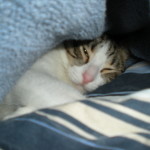 There are three groups that classify older cats:
There are three groups that classify older cats:
- 7-10 years (44-56 human years): Mature or middle-aged
- 11-14 years (60-72 human years): Senior
- 15+ years (76+ years for humans): Geriatric
With proper home and veterinarian care, many cats live into their late teens and early twenties.
It is important to understand aging changes, as well as what constitutes “normal” developments in additional to what signal signs of treatable conditions. This can be challenging because some owners might think that unlike dogs, cats do not need to visit the veterinarian on an ongoing basis. In fact, this couldn’t be further from the truth.
Cats are masters at hiding disease. Despite underlying problems, they may appear well. The American Association of Feline Practitioners recommends a veterinarian check-up every six months for a healthy, older cat.
What to Check for During a Routine Visit With Your Veterinarian:
- Overall body and weight condition
- Quality of the skin and coat
- Teeth, mouth and gums
- Ears and eyes
- Lungs and heart
- Abdomen
- Muscles and joints
Please make your veterinarian aware of any changes in condition from your previous exam.
Obesity is about more than just being “fat.” It is considered by veterinarians to be a disease that alters metabolism and makes a pet more likely to develop certain conditions, including but not limited to: diabetes, arthritis, heart disease, breathing problems and lower urinary tract disease.
At the opposite end of the spectrum in the senior and geriatric age group is a cat becoming underweight. Some older cats have a decreased ability to digest protein and fat, or it may be caused by a disease. Also keep in mind the fact that cats lose their sense of taste or smell as they age and this can cause loss of interest in eating. A broken tooth, chronic kidney disease or memory problems can also impact the ability to eat.
 One of the key elements to your cat’s continued good health is a proper diet. Older cats are prone to dehydration and constipation, so increased water intake is important for older cats. Also offering three or four small meals per day makes food easier to digest for older cats.
One of the key elements to your cat’s continued good health is a proper diet. Older cats are prone to dehydration and constipation, so increased water intake is important for older cats. Also offering three or four small meals per day makes food easier to digest for older cats.
Dental care is important to maintain your cat’s oral hygiene to help ensure continued health. Neglected teeth and gums can result in severe mouth pain and even lead to infection in other organs. Untreated oral disease and dental pain in your cat can cause her to experience emotional and physical decline.
A range of illnesses can occur as your cat ages. The most common are mentioned below:
Chronic Kidney Disease
Kidney disease often begins in middle age but is most common in older cats. Some signs may include:
- Mild behavior changes
- Changes in drinking frequency or location
- Excessive thirst
- Increased volumes of urine
- Constipation
- Appetite decrease
- Muscle decrease and weight loss
Diabetes
Diabetes is most common in obese male cats. It is a significant disease in older cats. Nearly half of all diabetic cats range in age from 10 to 15 years.
Signs include:
- Excessive hunger
- Weight loss
- Excessive thirst and urination
Other diseases that affect older cats are listed below but not limited to:
Thyroid disease
- Hypertension
- Gastrointestinal Conditions
- Cancer (About half of all deaths in cats aged 10 and older are caused by cancer)
- Arthritis
Even with appropriate treatment and regular veterinary care, many senior cats eventually reach a point where illness significantly affects their quality of life. If and when that time comes, it is important to include your trusted veterinarian in decided the best course of action for your pet.
Peace and Love are present in my world now,

![]()
